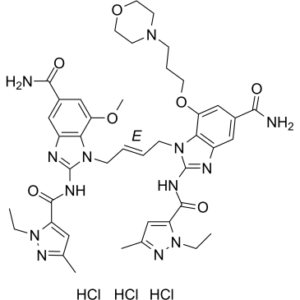diABZI STING agonist-1 trihydrochloride
This product is for research use only, not for human use. We do not sell to patients.

For small sizes, please check our retail website as below: www.invivochem.com
| Size | Price | Stock |
|---|---|---|
| 100mg | $2950 | Check With Us |
| 200mg | $4425 | Check With Us |
| 500mg | $7465 | Check With Us |
Cat #: V31645 CAS #: 2138299-34-8 Purity ≥ 99%
Description: diABZI STING agonist-1 (trihydrochloride) is a selective stimulator of interferon genes (STING) receptor agonist, with an EC50s of 130 for human PBMCs.
Top Publications Citing Invivochem Products
Publications Citing InvivoChem Products
Product Promise

- Physicochemical and Storage Information
- Protocol
- Related Biological Data
- Stock Solution Preparation
- Quality Control Documentation
| Molecular Weight (MW) | 959.32 |
|---|---|
| Molecular Formula | C42H54Cl3N13O7 |
| CAS No. | 2138299-34-8 |
| Synonyms | diABZI STING agonist-1 trihydrochloride |
| Protocol | In Vitro | diABZI STING agonist-1 is a selective stimulator of interferon genes (STING) receptor agonist, with EC50s of 130, 186 nM for human and mouse, respectively. At a concentration of 1 μM, diABZI STING agonist-1 (compound 3) demonstrates high selectivity against more than 350 kinases tested. |
|---|---|---|
| In Vivo | diABZI STING agonist-1 trihydrochloride (intravenous injection; 1.5 mg/kg; days 1, 4 and 8; 43 days) results in significant tumour growth inhibition and significantly improves survival (P < 0.001) with 8 out of 10 mice remaining tumor free at the end of the study on day 43. diABZI STING agonist-1 trihydrochloride (intravenous injection; 3 mg/kg) exhibits systemic exposure with a half-life of 1.4 h and achieves systemic concentrations greater than the half-maximal effective concentration (EC50) for mouse STING (200 ng/ml). diABZI STING agonist-1 trihydrochloride (subcutaneous injection; 2.5 mg/kg) induces STING-dependent activation of type-I interferon and pro-inflammatory cytokines in vivo. |
These protocols are for reference only. InvivoChem does not
independently validate these methods.
| Solvent volume to be added | Mass (the weight of a compound) | |||
|---|---|---|---|---|
| Mother liquor concentration | 1mg | 5mg | 10mg | 20mg |
| 1mM | 1.0424 mL | 5.2120 mL | 10.4241 mL | 20.8481 mL |
| 5mM | 0.2085 mL | 1.0424 mL | 2.0848 mL | 4.1696 mL |
| 10mM | 0.1042 mL | 0.5212 mL | 1.0424 mL | 2.0848 mL |
| 20mM | 0.0521 mL | 0.2606 mL | 0.5212 mL | 1.0424 mL |
The molarity calculator equation
Mass(g) = Concentration(mol/L) × Volume(L) × Molecular Weight(g/mol)
Mass
=
Concentration
×
Volume
×
Molecular Weight*
The dilution calculator equation
Concentration(start)
×
Volume(start)
=
Concentration(final)
×
Volume(final)
This equation is commonly abbreviated as: C1 V1 = C2 V2
Concentration(start)
C1
×
Volume(start)
V1
=
Concentration(final)
C2
×
Volume(final)
V2
Step One: Enter information below
Dosage mg/kg
Average weight of animals g
Dosing volume per animal µL
Number of animals
Step Two: Enter the in vivo formulation
%DMSO
+
%
+
%Tween 80
+
%ddH2O
Calculation Results:
Working concentration:
mg/ml;
Method for preparing DMSO master liquid:
mg
drug pre-dissolved in
µL
DMSO(Master liquid concentration
mg/mL)
,Please contact us first if the concentration exceeds the DMSO solubility of the batch of drug.
Method for preparing in vivo formulation:
Take
µL
DMSO master liquid, next add
µL
PEG300, mix and clarify, next add
µL
Tween 80,mix and clarify, next add
µL
ddH2O,mix and clarify.
Note:
- (1) Please be sure that the solution is clear before the addition of next solvent. Dissolution methods like vortex, ultrasound or warming and heat may be used to aid dissolving.
- (2) Be sure to add the solvent(s) in order.




































